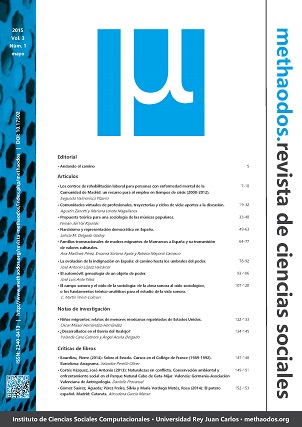The car: Genealogy of a power object
Main Article Content
Abstract
How it is built, investigated and polemic on cars as a privileged object of the industry and society in the Western market. The car on their own dimension of individuality, but also an object of consumption can be read while it is used; one could say that the car is the social object that represents the individual, in that form of discipline and social control. While the symbol, too, of this enormous machine that is power. Ultimately, it is an object showing the tensions between the individual and the social. Then, we affirm in this work is not just a machine, but also the most complete example of social technology, political representation and performativity of today.
Downloads
Article Details
References
Anta Félez, J. L. (2007): “Automóviles en la frontera norte de México. Una (primera) reflexión del y para el trabajo de campo”, Gazeta de Antropología, 23: 02.
— (2013): “La hermenéutica del automóvil: utopía, (des)memoria y metáfora”, Nómadas. Revista Crítica de Ciencias Sociales y Jurídicas, 40 (4): 11-22. http://dx.doi.org/10.5209/rev_NOMA.2013.v40.n4.48332
Appadurai, A. ed. (1991 [1986]): La vida social de las cosas. Perspectiva cultural de las mercancías. México: Grijalbo-CONACULTA.
Barthes, R. (1980): “El nuevo Citroën”, en Mitologías: 154-156. Madrid: Siglo XXI.
Basham, F., Ughetti, B. y Rambali, P. (1994): Car Culture. Medford, NJ: Plexus Publishing.
Baudrillard, J. (1969): El sistema de los objetos. Mexico: Siglo XXI.
— (2009): La sociedad de consumo. Sus mitos, sus estructuras. Madrid: Siglo XXI. (Orig. 1970).
Bericat Alastuey, E. (1994): Sociología de la movilidad espacial. El sedentarismo nómada. Madrid: Siglo XXI-CIS.
Bourdieu, P. (1988 [1979]): La distinción. Criterios y bases sociales del gusto. Madrid: Taurus.
Boyer, R. y Freyssenet, M. (2001): “El mundo que cambió la maquina. Un nuevo esquema de análisis de la industria del automóvil”, Sociología del Trabajo. Revista Cuatrimestral de Empleo, Trabajo y Sociedad, 41: 3-45.
Buxó i Rey, M. J. (2007): “La ciudad de los coches”, en Calatrava, J. &, González Alcantud, J. A. Coords.: La ciudad: paraíso y conflicto: 75-90. Sevilla: Junta de Andalucía, Consejería de Obras Públicas y Transportes.
Delgado, M. (2007): Sociedades movedizas. Pasos hacia una antropología de las calles. Barcelona: Anagrama. http://dx.doi.org/10.4067/S0250-71612007000100010
Dorfles, G.(1973): “El automóvil como «status symbol»”, Triunfo, XXVIII (570): 28-30.
Ehrenburg, I. (2008): Historia del automóvil. Barcelona: Melusina.
Flink, J. J. (1990): The Automobile Age. Cambridge, MA: The MIT Press.
Garcia Ochoa, S. (2008): “El Automóvil y la Cultura del Siglo XX: una Reflexión Antropológica”, situArte, 3 (5): 25-32.
Geertz, C. (2005 [1979]): Le souk de Sefrou. Sur l’économie de bazar. París: Bouchène.
Grupo Marcuse (2009): De la miseria humana en el medio publicitario. Barcelona: Melusina.
Haugen, D. M. y Box, M. J. eds. (2005): Examining Pop Culture. Cars. Independence, KY: Greenhaven. http://dx.doi.org/10.1177/1354856507079182
Horst, H. y Miller, D. (2006): The Cell Phone: An Anthropology of Communication. Oxford: Berg.
Horta, G. y Malet Calvo, D. (2014): Hiace. Antropología de las carreteras en la isla de Santiago (Cabo Verde). Barcelona: Pol·len.
Jakle, J. A. y Sculle, K. A. (2005): Lots of Parking: Land Use in a Car Culture. Charlottesville, VA: University of Virginia Press. http://dx.doi.org/10.7202/1016014ar
Martínez Magdalena, S. y Meléndez Suárez, M. G. (2014): “Thelonius on the road. Posibilidades kickwriting para una road ethnography en la España precaria tardocostumbrista”, Revista de Antropología Experimental, 14: 225-254.
Miller, D. ed. (2001): Car Cultures. Materializing Culture. Oxford: Berg.
Myers, F. R. ed. (2001): The Empire of Things: Regimes of Value and Material Culture. Santa Fe, NM: School of American Research Press.
Queiroz, R. da S. (2006): “Os automóveis e seus donos”, Imaginário, 12-13: 113-122. http://dx.doi.org/10.11606/issn.1981-1616.v12i13p113-121
Raunig, G. (2008): Mil máquinas. Breve filosofía de las máquinas como movimiento social. Madrid: Traficantes de Sueños.
Toledo, V. M. (2002): “La religión del automóvil”, Ecología Política, Cuadernos de debate internacional, 23: 9-11.
Torres Sad, D. (2011): “Taxi, objeto antropológico”, Antropología. Boletín Oficial del INAH, 93: 23-28.
Urry, J. (2003): Global Complexity. Cambridge: Polity. http://dx.doi.org/10.1177/0263276405057201
Volti, R. (2006): Cars and Culture: The Life Story of a Technology. Baltimore, MD: Johns Hopkins University Press.
Wollen, P. y Kerr, J. (2004): Autopia: Cars and Culture. Londres: Reaktion.
Wright, P. (2013): Imaginarios, símbolos y coreografías viales: una perspectiva antropológica. Buenos Aires: UBA.

